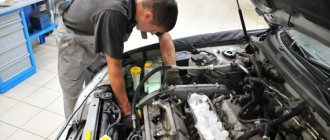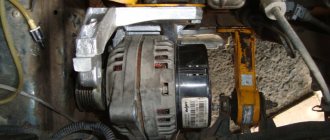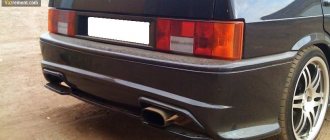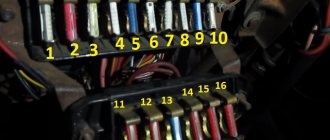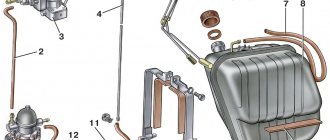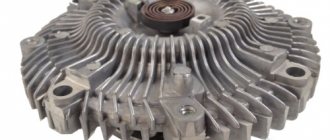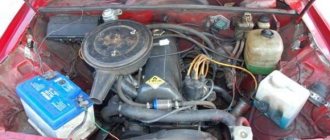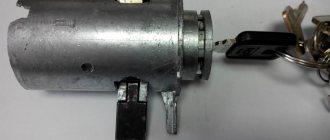With the onset of summer heat, air conditioning becomes the only salvation for motorists who are forced to spend a lot of time behind the wheel. But this rather complex device tends to act up sometimes, and most often this happens at the most inopportune moment. In most cases, the cause of the malfunction lies in the compressor - this is the most loaded component of the climate system. If the breakdown relates to other components, these are mostly minor troubles that you can fix yourself and without extra expenses. With a compressor, the situation is much more serious; its repair is usually expensive, and the reasons for its inoperability can be very different. How to diagnose a malfunction, how to determine what is more profitable, repair it yourself, take it to a service station or replace the entire unit with a new one - we will try to give a detailed answer to these and other questions.
How to repair a car air conditioning compressor.
The compressor is the main component of the air conditioning system
The operating principle of a car air conditioning compressor is practically no different from the operation of a household refrigerator compressor. Essentially, these are “close relatives” in the world of technology. It should not be surprising that the internal structure of these cooling systems is identical. At the very least, the compressor is one of the main components of both the refrigerator and the car air conditioner. It can be called the heart of the device, pumping freon through the blood vessels instead of blood. All modern climate control systems are equipped with two types of compressors: rotary vane and piston.
The operating principle of a rotary vane automobile compressor is reminiscent of the operation of an electric pump used to inflate a mattress. Its main part is a rotating rotor, the blades of which create a vacuum that draws in the refrigerant from one side and pushes it into the main line under a certain pressure, forcing the freon to circulate in a closed circuit throughout the entire operating time of the air conditioner.
The main part of piston compressors is the piston, which forces the refrigerant to be compressed in the working chamber and circulate through the main line under the influence of pressure. The design of piston compressors can be different - with one or more pistons, with different orientations (V-shaped, as in a car, located in the same plane or cross-shaped).
There are other types of compressors - if you wish, you can count up to forty different modifications, but they are all variations of two main types. Therefore, it makes no sense to dwell on a detailed description of each variety - they all perform one task: they force the refrigerant to move in a vicious circle, entering the condenser, dryer, receiver, evaporator and other components of the air conditioning system.
Selection rules
When choosing a drain pump for an air conditioner, you should proceed from its required performance. The average rate of condensate production by any air conditioner is 500-800 ml/hour. per 1 kW of “cold production”. Five-kilowatt equipment operating in the “cold production” mode releases liquids, on average 2.5 -4 l/h. The pump should be selected with a similar performance.
For household split systems with a wall-mounted evaporator module, separate versions of the device would be preferable. Next, you should choose the quietest one available on the domestic market, but with the required performance.
Compressor design features
Since the compressor is the main consumer of energy in the climate system, its tasks include the most labor-intensive part of the work - creating the required pressure in the system. In addition, according to the laws of thermodynamics, the molecules of a compressible gas heat up, and under the influence of pressure the gas turns into a liquid state. Strictly speaking, the possibility of changing the state of aggregation of the refrigerant is the fundamental principle that underlies this method of cooling warm air forced from the passenger compartment. Freon is a substance that, under the influence of pressure, easily becomes either a liquid or a gas, heating and cooling accordingly.
Car air conditioning compressor design
The task of the compressor is to ensure the movement of freon in a closed circuit. After the compressor, the freon enters the condenser, where, thanks to the air blown by the fan, it cools, condensing on the radiator tubes, changing its state of aggregation to liquid. Passing through the receiver, the refrigerant is cleared of contaminants and enters a temperature-controlled valve, the task of which is to inject freon into the evaporator in a dosed manner. This is the unit that is directly responsible for cooling the interior. Here, the refrigerant in the form of an aerosol cools even more, turning into a gaseous state. The working body of the evaporator is a radiator, or a system of tubes. By contacting them, freon cools their surface, and the fan blows the cold back into the cabin.
The refrigerant moves on, being in a sufficiently cooled state, getting back into the compressor. Thus, the circle is closed, ensuring a continuous flow of cold air into the car interior. The area from the compressor to the expansion valve is called the high pressure line, the area from the evaporator to the compressor is called the low pressure zone. The operating parameters of the car air conditioner are monitored by sensors: in case of excess pressure, which occurs, for example, when the car is stuck in a traffic jam, the fan turns on at full power, helping the condenser do its job - convert gas into liquid and thereby relieve the line. If this does not help, the emergency pressure sensor is triggered, turning off the air conditioner.
We have already mentioned that the compressor consumes a lot of energy, taking away about 5 - 15 horsepower from the power unit, and this power take-off on weak engines has a very noticeable effect on the dynamic characteristics. In addition, a working air conditioner causes an increase in fuel consumption (up to 1 liter per 100 km), which forces many drivers to drive with the air conditioning system turned off, despite the hellish heat. It is clear that open windows are ineffective at low speeds, and at high speeds they are a powerful source of drafts. So if you want to drive in comfort, you need to come to terms with additional costs and reduced engine response.
Types of equipment
The entire range of pumps for air conditioners can be divided into three main groups:
- Liquid.
- Separate.
- Peristaltic
Filling pumps are made in the form of a reservoir, tank or block. This type of drainage pump requires placement under the air conditioner pan (below its level), since it allows condensate to enter it by gravity. When the container is filled with condensate, the sensor is triggered and the pump turns on, and after pumping out the water it goes into sleep mode again.
However, bulk drainage pumps are quite large - to match their power and performance. Therefore, it is advisable to apply these models to powerful split systems or to a whole group of air conditioners.
The operating principles of bulk pumps involve the use of predominantly horizontal routes to drain water into the sewer system. And this is not always convenient.
Pumps of a separate design can even be installed directly in the drainage route - it all depends on the needs of the user. One of the advantages of this type of drainage pump is the ability to pump water out even from a two-meter distance from the innermost unit of the air conditioner.
In addition, this device is very suitable when it is necessary to drain condensate up the pipes. A separate drainage pump allows you to raise water to a height of about 15 meters.
Peristaltic models are quite specific and are intended for use in certain conditions - in the presence of a significant length of vertical sections of the route and elevation changes. The minimum pressure force of such models is 15 meters.
Causes of compressor malfunctions
Many even quite experienced drivers are misled, believing that the compressor is the most reliable component of a car air conditioner and that there is simply nothing to service there. Sooner or later, such beliefs lead to the appearance of symptoms in the compressor operation that were not there before. For example, a hum when the air conditioner is turned on. Since it is not always possible to determine the source of extraneous noise due to engine operation, if the car owner does not act, the compressor quickly becomes faulty, which may require expensive repairs or complete replacement of this unit.
The second most common compressor malfunction is clutch failure. If, when you turn on the air conditioner, you do not hear a characteristic click, which means that the clutch has engaged with the pulley, this is precisely an indication of a problem in this compressor unit. The electromagnetic clutch may break due to overheating of the compressor (for example, during prolonged operation of a stationary vehicle in high ambient temperatures), as a result of which the coil wiring melts. There may also be a manufacturing defect in the coupling itself, which manifests itself in the formation of an unacceptably large gap between the pulley and the pressure plate.
If the car is old, then the reason for the loss of performance of the clutch may be its elementary wear. Repair of a car air conditioning compressor in this case is carried out by replacing the coupling, which is done in almost the same sequence as installing a new bearing.
Compressor failure can be caused by clogging or depressurization. In the latter case, the problem can be eliminated by simply tightening the connections, if this is the reason for the depressurization. To clean the compressor, you need to disassemble it, rinse it thoroughly and replace the repair kit. If you have never disassembled a car air conditioning compressor, it is better to entrust this operation to professionals, especially if the housing parts have been damaged. Perhaps the compressor's inoperability is caused by clogged main pipes. It is difficult to diagnose such a malfunction, but you can clean or replace the tubes yourself.
The cause of noise when the car air conditioner is turned on and operating may be the lack of operating pressure on the discharge line. If the pressure gauge readings indicate this, the compressor may also be at fault - due to natural wear, due to filling in too much freon, or due to its leaks. In such cases, troubleshooting of the compressor is carried out, which makes it possible to clarify the nature of the malfunction and begin repair work.
Leakage is another common cause of compressor breakdowns. Typically, this result is caused by either loosening of the main pipeline or damage to the seal. In the latter case, it is unlikely that you will be able to replace it yourself - it is much more difficult than replacing a bearing. However, you can reduce the cost of repairing a car air conditioning compressor if you remove it yourself and bring it to the workshop in this form. As practice shows, one month of driving on a leaking oil seal is enough for the compressor shaft (or rather, its outer part) to be completely covered with corrosion. So it will most likely need to be removed and sanded.
Piston jamming is the most serious compressor failure. Here, one replacement is not enough, since usually a broken piston damages both the cylinder walls and the valves. In such cases, the best option for restoring the functionality of the compressor and the entire air conditioning system is to completely replace it with a new unit.
Insufficient lubrication of parts
Sometimes car enthusiasts use too little oil to lubricate elements or do it irregularly. In such cases, it will be necessary to overhaul the air conditioning compressor in the car. Otherwise, insufficient lubrication in the future will result in:
- Breakage of the bearing that occupies space in the constant rotation pulley. Strong heating of the bearing during operation leads to distortion of the pressure disk or burnout of the varnish on the electromagnetic clutch.
- Abrasion of the walls inside the case. As a result of strong friction of unlubricated parts, metal dust appears, which settles on rubber hoses, aluminum tubes, in the evaporator and other parts of the system, leading to jamming.
This is interesting: Aisin automatic transmissions: 5 advantages of the mechanism
Sometimes low-quality lubricants containing large sediments are poured into the system. Then, during operation of the air conditioner, this sediment inevitably clogs the thermostatic valve and the receiver. To correct the situation, you will have to replace them with new ones, having first cleaned other parts of the air conditioning system.
Replacing the compressor pulley bearing
Most often, the presence of noise indicates that the compressor pulley bearing is worn out, or there are abrasions or other defects on the belt drive. In both cases, a monotonous hum can occur even when the air conditioner is turned off but the engine is running.
If you do not replace the bearing or belt as soon as you notice suspicious sounds from under the hood, the consequences can be very sad. Usually, due to overheating of the bearing, the electromagnetic coil that drives the clutch fails. The bearing sooner or later jams, which causes the compressor cover to break and many small cracks to appear at the end of the device. But even if the front cover remains intact, a leak in the seal will lead to a leak of refrigerant, which is also a lubricant for the compressor shaft (special oil is added to the freon composition). As a result, the shaft overheats, which can cause the compressor to catch fire.
It is also possible that the pulley is skewed, causing uneven wear and jamming of the compressor. It is also possible for the belt to break, which can cause irreparable damage to electrical wires within reach. To prevent such situations, the crumbling bearing should be replaced as soon as possible.
A similar operation can be performed independently, if you have a regular set of tools. The replacement sequence is as follows:
- after installing the car on the pit, remove the wheel from the compressor side;
- unscrew the four (less often three) bolts that secure the compressor to the frame; if the generator interferes with this, you will have to remove it too;
- unscrew the nut that holds the clutch pressure plate and dismantle it;
- Under the pressure disk there is a retaining ring that holds the pulley with the bearing installed on it. Removing the ring is easy, after which you can remove the pulley;
- Since the engine compartment of a modern car is filled very tightly, there are situations when it is technically impossible to remove the pulley without disconnecting the compressor from the air conditioning system. In this case, you must first remove freon from the system by slowly loosening the clamps holding the rubber tube on the compressor. Rapid weakening is undesirable, since in this case the freon under pressure will escape from the system, which can pose a danger to both the car and the driver carrying out the repair;
- The bearing is usually secured by a retaining ring, which is quite easy to remove. If it is flared, you will have to use the old proven method - a hammer and chisel. You can pull out the bearing either with a puller or using a cage from another bearing of the same or slightly smaller diameter;
- All that remains is to install a new bearing and reassemble all components in the reverse order.
Installation required
Many air conditioner users may doubt the need for such a pump at all, since standard air conditioning units are equipped with a tube for removing condensate to the outside. However, this method of getting rid of excess fluid has its negative sides:
- The presence of constantly flowing water during the hot season. This can cause trouble both for the owner of the device, since it pollutes the facade, damages the cladding of the house, flows onto the blind area, etc., and for his neighbors below, if any.
- Environmental pollution.
- It is impossible to use the air conditioner in cooling mode in winter, as the drain hose may freeze.
In addition, there are a number of other reasons that do not allow using the traditional method of draining a split system.
Even if the air conditioning unit is already equipped with a drainage pump, the room may simply not have the necessary conditions for installing proper condensate drainage. This happens if the container for collecting liquid categorically does not fit into the interior of the room, and it is unprofitable to drain it to the sewer system due to the large distance. In this case, it is also recommended to purchase a drainage pump.
A little about oil in refrigerant
Any repair of the compressor is fraught with an imbalance of the oil added to the freon to ensure lubrication of the car air conditioner parts. Since you find yourself forced to restore the compressor’s performance, it would be useful to take into account several recommendations based on experience in repairing climate control systems.
If you are doing work that requires complete dismantling of the compressor, keep in mind that there is still oil in the system, albeit in small quantities - unlike volatile freon, it does not have time to drain either from the lines or from other air conditioner components. To drain these residues, you will have to flush the system. It's expensive, but necessary.
When charging with freon, the required amount of oil has already been added to it, so flushing allows you to achieve the ideal ratio of refrigerant to lubricant. The algorithm for determining the required amount of oil in the system is as follows:
- determine its quantity in the removed compressor;
- Find out from the documentation how much oil there should be;
- subtract the first digit from the last digit and remember the difference;
- When you drain oil from the lines, make sure that its volume is less than or equal to the saved calculated value. If there is excess oil in the system, there is no need to drain it.
Typically, after repairing a compressor, oil needs to be added. How much to add is important, since its excess will cause jamming of the compressor and its complete replacement. If you know how much oil has drained, fill in the same amount plus 40 grams, and it is recommended to use the same type of lubricant. It is also necessary to know that topping up should be carried out exclusively through the high-pressure port - otherwise there is a possibility of creating insufficient vacuum inside the line.
Troubleshooting yourself
Once the cause of the malfunction has been determined, you can repair the car air conditioning compressors yourself. To do this, you will need to remove the refrigerant from the cooling system and open the compressor. The further algorithm of actions will depend on which part needs repair or replacement:
- Stuffing box . Dismantle the coupling hub, remove the locking element securing the gasket. In place of the old oil seal, install a new one using a special mandrel, and reassemble in the reverse order.
- Shaft bearing . Dismantle the electric coupling, remove the worn bearing, replace it with a new one.
- Electro coupling . Disassemble the supercharger. Remove the failed part - coil, shaft or pressure plate. Insert a new element and assemble the supercharger.
- Pump . In most cases, problems can be resolved by simply adding oil to the system. If the pump stops working due to large amounts of sediment or aluminum dust, the mechanism should be thoroughly flushed.
When the compressor housing has minor damage in the form of cracks, holes or chips, they can be easily repaired without dismantling the compressor. You just need to turn it off and seal the holes and cracks using argon-arc welding.
This is interesting: Oil for car air conditioners - a choice according to all the rules
Replacing, washing, refilling the compressor
We have already talked about some malfunctions that require a complete replacement of the compressor. These include cases related to improper installation of the air conditioning system, as well as non-compliance with operating rules. Disassembling the car air conditioning compressor in such cases is practically useless. Usually, in a car service center, having discovered a refrigerant leak, they limit themselves to replacing filters, eliminating leaks and refilling the system. However, in most cases, such a malfunction needs to be treated in a more radical way, since when depressurizing moisture inevitably enters the system, which requires flushing, and in some cases, disassembling the compressor and cleaning all its components that have been exposed to aggressive dirt and moisture.
Flushing should be carried out in stages, and either carbon tetrachloride or varieties of freon (R11/R113) should be used as the flushing liquid. The first stage is to completely remove any remaining contaminated refrigerant using an evacuated can. Then flushing with the indicated liquids is carried out, which should be carried out until a transparent substance begins to flow out of the compressor. After this, you should fill the system with a mixture of freon R11/R113 and oil, taken in the same proportions, turn on the air conditioner and let it run for 10 - 15 minutes, then drain the mixture. After flushing the compressor, it is necessary to evacuate it, which will force out the remaining flushing liquid.
And only after this the system is filled with a special oil that is highly hygroscopic (the ability to intensively absorb water from the atmospheric air). Therefore, when pouring oil, you need to try to prevent its contact with the air. To rid the system of moisture that somehow gets into the compressor, the unit is finally purged using dry nitrogen or any gaseous refrigerant.
You should know that for a new car (or after installing a new air conditioning system), freon is charged once every 2 years, and after 6 years of operation of the air conditioner - annually. Extending the service life of the compressor can be achieved by periodically turning on the air conditioner for 10 - 15 minutes when the car is idle for a long time (including in winter). This operation should be performed at least once a week.
Types of structures
Most often, drainage pumps for air conditioners are selected based on their power rating. It is imperative to take into account the rate at which condensation appears. Installing a pump eliminates the overflow of liquid that collects in the pan. An air conditioner with such a device will be completely autonomous
There are several types of drainage system, the list of which includes those that are important for a potential buyer to familiarize themselves with
- Separate type design. The device is equipped with a special tank that contains a sensor that determines the water level. This design can be mounted on a training track, pipes or inside compartments intended for condensate. Most often, the equipment is installed as a separate element that is connected to a pan and a tube. The productivity of such models is 7–60 liters of water per hour. If used correctly, the device transports condensate to a height of up to 15 meters. In cases where the operating conditions are quite specific, the choice of such a pump is not relevant.
- Self-leveling structures. They have a good tank volume, but there is no water level control sensor. The power of such types of contraction is higher than that of the separate type. The productivity indicator reaches 80–1500 liters per hour. The model also has disadvantages - the inability to raise the liquid high. The intended maximum is 7 meters. Such systems are used for external split systems, which provide for the removal of liquid into the sewer system.
- Built-in type structures. Most often, they are used for duct and cassette air conditioners. Their productivity reaches 5-165 liters per hour. They are relevant when operating in extreme conditions, not counting those situations where there is a need for additional vacuum to remove condensate.
- Peristaltic type structures. They lift condensate well to a height of up to 15 meters, but have low productivity. As a rule, it reaches 10 liters per hour. Such models also have a high cost.
The operation of the drainage system should be quiet. Regarding the external manifestations of the operation of the device, a small stream of water flowing from the air conditioner is visible. A good sump pump is very quiet. They have a long service life and are most often purchased only once. It is quite difficult to break such a device, but it is possible. Breakdown can be caused by lack of prevention, as chemical elements and dirt accumulate inside the system. If you properly care for the device, it will last a very long time.
Self-leveling structures do not have a water level sensor
Replacing the coupling
The clutch is an essential element of a car air conditioner, providing a connection between the compressor shaft and the drive pulley, which rotates constantly, regardless of whether the climate system is on or inactive. Currently, several types of electromagnetic couplings are used, and each type requires the use of its own oil. If this requirement is not met, the coupling is guaranteed to fail much earlier than the mean time between failures. Since the clutch is connected to the pulley, it constantly rotates with it. When you turn on the car air conditioner, you hear a click, which indicates that it has engaged with the compressor shaft, thereby putting it into action.
If a click is not heard, and there is audible noise in the area of the clutch, this is a clear sign that this compressor element is faulty. There are also situations when, according to all external symptoms, the coupling should be working, but the transmission of rotation from the engine to the compressor shaft does not occur. In such cases, diagnostics using special equipment helps to localize the cause of the malfunction. Note that such devices are quite expensive, so they are not found at every service station.
Note that due to the simplicity of the design, the drive coupling is considered a fairly durable unit that breaks relatively rarely. In any case, repairing a car's air conditioning compressor clutch is less profitable than replacing it, since it is inexpensive. And the replacement operation itself is quite simple (especially if you have already dismantled the compressor).
Repair of tubes and hoses
Timely diagnosis of connecting hoses coming from the compressor and exposed to high pressure is a guarantee of long-term operation of both the compressor and the entire climate system. If the recommended frequency of inspections is observed, the service life of a car air conditioning compressor can be increased by one and a half to two times. The problem is that main hoses are subject to shocks and vibrations that are inevitable when driving on imperfect roads. Another risk factor is the close proximity of the hoses going directly to the compressor to the exhaust manifold - a source of increased temperature. As a result, it is in these places that drying out and cracking of main pipelines most often occurs, which threatens the depressurization of the system.
The same result is possible with the aging of various rubber products - gaskets and sealing rings. Finally, loss of tightness is also possible on metal tubes that are susceptible to corrosion. Therefore, it is so important to regularly visually inspect the main pipelines (especially in the high-pressure section) and in all places where refrigerant leakage is possible. Oil stains will tell you that this is the case. In such cases, immediate repair of leaky elements (hoses, tubes, gaskets, o-rings) will be required, and if this is not possible, their complete replacement.
